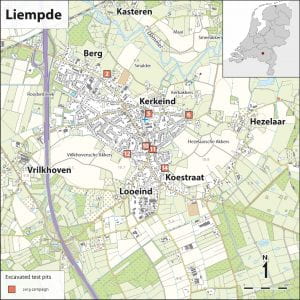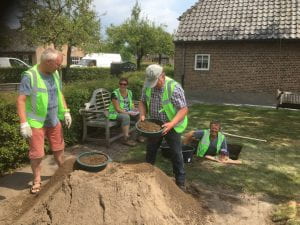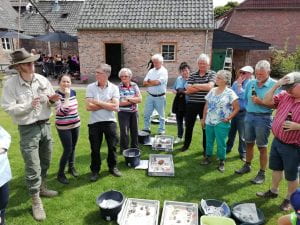 Seven test pits were excavated by more than 40 volunteers in Liempde in July 2019 organised by the local history club ‘Erfgoedvereniging Kèk Liemt’. The excavations aimed to establish when the medieval settlement clusters at the town hall and the Kerkeind barn church were first occupied and to see whether they were new foundations or developed from existing settlement.
Seven test pits were excavated by more than 40 volunteers in Liempde in July 2019 organised by the local history club ‘Erfgoedvereniging Kèk Liemt’. The excavations aimed to establish when the medieval settlement clusters at the town hall and the Kerkeind barn church were first occupied and to see whether they were new foundations or developed from existing settlement.

The excavations showed that, contrary to general expectations, the historical layers were mostly well-persevered. The site of the former Kerkeind barn church turned out to be built up prior to the construction of a new rectory in 1867 following a fire in 1864 that destroyed much of Kerkeind including the church and old rectory. In test pit 5 fourteenth/fifteenth century pottery was discovered underneath an intact late medieval ploughsoil, indicating that the site was on the edge of the arable fields with settlement probably nearby. On the east side of Kerkeind test pit 6 was dug in the backyard of a farm that was demolished in the nineteenth century. This showed the site lay in the former vegetable garden, with the neck of a wine bottle dating to the late seventeenth or first half of the eighteenth century found at the bottom of the ploughsoil.

The pit in the town hall area yielded a variety of finds (pottery, glass, clay pipe, coins, etc.) dating from the sixteenth century up to the present day. One of the most remarkable pieces was a 30mm diameter piece of seventeenth/eighteenth century cast iron grape shot. This might be a relic of the Eighty Years’ War, but could also be associated with the War of the First Coalition when British, Dutch and Austrian troops were pushed back by French republican forces, which led to a confrontation in the neighbouring market town of Boxtel in September 1794.
